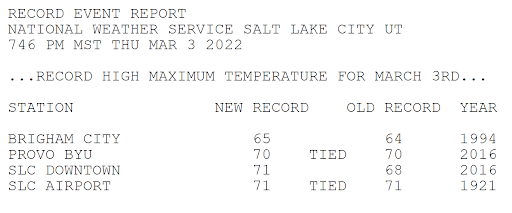I'm increasingly excited about a storm currently moving into Utah tonight. It is arriving from off the Pacific, so it contains moisture-laden air, in contrast to most our storms since January. As colder air arrives through the evening, rain will transition to snow across nearly all I-15 valleys, except the far south. As always, the devil is in the details. I will get to the valley snow potential in a moment.
First, I should mention most valleys have fallen behind in snowfall and liquid precipitation for the current water year (Oct 1st, 2021 to end of Sept 2022).
Salt Lake City International Airport has not received 2" or more of daily snowfall since 3.6" fell on December 31st, 2021. I can only think of one word-- Ugh! Okay, two words-- Abysmal!
Take a look at the water year statistics for the Salt Lake City Airport:
I wonder how the north-end of the Wasatch Front is faring with snow? Take a look at Logan, Utah:
Even if we have an active March, it will be extremely difficult to end the year with even near-average snowfall. Storms tend to deliver lighter snow amounts in the valleys (and mountains) as we progress through the month.
Now, let's assess the upcoming storm. The water vapor satellite loop, overlaid with the upper level low, is a good place to start:
An important feature to recognize, is the bright moisture band lifting NE into Utah ahead of the low center. For more intense precipitation rates (rain or snow), you need strong lift. Notice, the upper level divergent (or diffluent) winds, spreading out, as evident by the direction of the arrows. This "stretching" aloft, allows dense air below to rise. As the air cools and condenses, precipitation falls.
Air can be lifted in other ways as well. Here is another area of lift caused by low level convergence:
Notice, surface low pressure is drawing wind flow in from the north and south. This is referred to as "frontogenesis" by meteorologists. The colliding air at the surface can only go in one direction, and that's up! So, additional lift, good for heavier precipitation.
Lift and moisture are currently coming together over northern Utah. An intense band of rain is developing, and even some embedded thunder. The faster rain switches to snow in valleys, the higher amounts are likely to be. The heaviest snow is expected to fall from around 10 pm tonight to 10 am Thursday, give or take.
Model ensembles are helpful for looking at potential snow amount ranges for SLC. These are 50 runs of the same model to give a range of outcomes. It's helpful for looking at low, average, and higher-end estimates. This is a point forecast for SLC only!
Focus on the green line, which is the average through Sunday afternoon. It indicates close to 4" at the airport. I might knock off 1" if snow doesn't start to accumulate by 10 PM. The ground is warmer this time of year, after all.
The National Weather Service is a government forecast entity. I consider their forecasts, as "official" vs. TV or weather apps. Here's their forecast:
The National Weather Service looks at all the variables, and devise with their own forecast. Sometimes they are closest (compared to private sources), other times not. They're going 4-6" from SLC to Ogden. 6-8+ inches benches. Less to the south in Utah County, and also areas north of Ogden. That's very reasonable.
One more model to evaluate is the University of Utah, down-scaled version of the GFS. The higher resolution picks up smaller-scale weather features and terrain influences. It puts a sloth of 4-8 inches across the entire Salt Lake Valley through Sunday morning. This is further south than most other models, which put the heaviest amounts from the north-end of the Salt Lake Valley to around Ogden.
We won't know much more until we look out the window Sunday morning. Snow should continue into the early afternoon hours, and begin to taper off. Areas east of I-15, benches, and mountains could still get meaningful accumulation Sunday afternoon. Increasing NW flow could still squeeze out 1-2" due to orographic (or terrain) lift in those areas. Up to 2 feet could fall in total at some favored Ski Resorts.

















